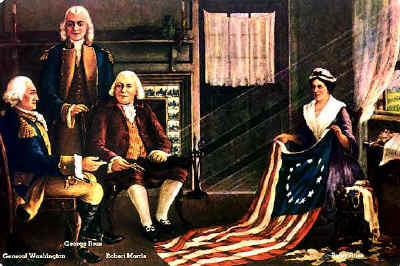

Betsy Ross and the First American Flag
Author Unknown
In late spring of 1776 Betsy met in a secret meeting with George Washington, George Ross, and Robert Morris, a committee of three representing the Continental Congress. This meeting is what led to our American flag.
At this time George Washington was head of the Continental Army. He and his wife Martha often attended church with Betsy Ross and her husband at the Christ Church. And possibly, according to Betsy's daughter, Betsy embroidered ruffles for George Washington's shirts. They were friendly enough that George Washington occasionally called on the Rosses socially in their home. Robert Morris was believed to have possibly been the wealthiest citizen in the colonies. And Colonel George Ross was a prominent Philadelphia citizen and an uncle to Betsy Ross by marriage.
It had been decided the flag should be red, white, and blue, with stars and stripes representing the colonies. George Washington had anticipated 6-pointed stars on the flag. He presented Betsy with a rough draft of the committees expectations. Betsy Ross demonstrated how to cut a 5-pointed star "in a single snip."
She made such an impression with her skills she was allowed to make the flag using the 5-pointed star. Betsy finished the first American flag in late May or early June of 1776. And in July 1776 the Declaration of Independence was read at Independence Hall. The liberty bell tolled and America celebrated her freedom :-) The flag was officially adopted on June 14, 1777, by the Continental Congress. They resolved: "that the flag of the United States be thirteen stripes, alternate red and white; that the union be thirteen stars, white in a blue field, representing a new constellation."
About Betsy Ross:
Betsy, was the eighth child out of seventeen children born to Samuel and Rebecca Griscom....making her a fourth generation American. She was born on January 1, 1752 and named Elizabeth Griscom. Betsy went to a Friends (Quaker) public school. Here she learned basic skills as well as sewing skills. Upon completing her education she became an apprentice to a local upholsterer. In colonial times upholstery shops performed various jobs of sewing. Here she met John Ross, who was the son of an Episcopal assistant rector at Christ Church. Quakers were not in favor of inter-denominational marriages. Such a marriage caused a member to be "read out" of the church and community. This didn't stop Betsy from marrying outside her faith. At the age of 21, she eloped with John Ross in November of 1773, causing a break in her association with her family. Within two years of their marriage, the couple began their own upholstery business. Since being forced to leave the Quaker faith, Betsy joined her husband at the Christ Church.
War began in 1776. The war hurt John and Betsy's business. Fabrics were in short supply. John joined the militia. He was wounded in mid-January and died on the 21st of the month. Around this time is when Betsy Ross was given the honor of sewing the first American flag. After the death of her husband, Betsy was allowed back into the Quaker religion. Quakers were not allowed to bear arms and so they remained somewhat neutral during the revolution. However when any Quakers went against the church and met for war efforts.....Betsy joined them.
In June of 1777 Betsy married a sea captain, Joseph Ashburn. The British Army occupied Betsy and Joseph's home during the winter months, while the Continental Army spent a winter of hardship at Valley Forge. During this time Betsy and Joseph had Zillah, who died in her youth, and Elizabeth. Captain Ashburn was captured by the British on a trip to get war supplies for the Revolutionists. He was taken to Old Mill Prison in England. He later died there just before the end of the war. Betsy heard of her husband's death after the war from John Claypoole, an old friend. She married John Claypoole in May of 1783 at Christ Church.
Claypoole gave up the sea for a job in Betsy's upholstery business....later he worked for the U.S. Customs House. John and Betsy had five daughters....Clarissa Sidney, Susannah, Rachel, Jane, and Harriet, who died at nine months. John died in 1817 and Betsy spent the remainder of her life alone. She continued running the family business and gave employment to many of her relatives as time passed. When she eventually retired she lived with her daughter Susannah Satterthwaite.
By the year 1834 only Betsy Ross and Samuel Wetherill were meeting at the Quaker House and so they closed the building. Betsy died on January 30, 1836, at the age of 84. She was first buried at Christ Church Cemetery, later moved to Mt. Moriah Cemetery, and currently rests on Arch Street in the courtyard adjacent to the Betsy Ross House.
Previous Story Back to Calendar Next Story